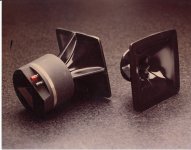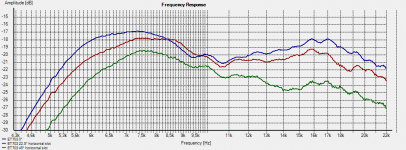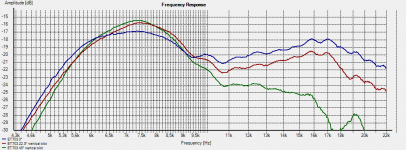Radian does have Beryllium-diaphragm drivers with 1" exits -- the 450BePB, 465BePB and 475BePB, but these all have ferrite magnets.
When I swapped out the 745PB (aluminum-ceramic) for the 745NeoBePB, the improvement was enormous. I don't know how much difference was made by the change in diaphragm material and how much by the magnet material (I haven't yet heard the 745NeoPB).
It has been a long time since I have heard the TAD 2001 drivers, but in my friend's system I remember them sounding excellent, and definitely didn't need tweeters. But the reproduction of strings wasn't as realistic and natural as what I'm getting now, so I don't feel like I'm missing out.
Gary Dahl
When I swapped out the 745PB (aluminum-ceramic) for the 745NeoBePB, the improvement was enormous. I don't know how much difference was made by the change in diaphragm material and how much by the magnet material (I haven't yet heard the 745NeoPB).
It has been a long time since I have heard the TAD 2001 drivers, but in my friend's system I remember them sounding excellent, and definitely didn't need tweeters. But the reproduction of strings wasn't as realistic and natural as what I'm getting now, so I don't feel like I'm missing out.
Gary Dahl
I agree those Faitals look good but the Celestions are cheap.
Those prices are sure a lot nicer than the Be Radians!
Pooh didn't say so here but he's had all sorts of 1" drivers in and out of his system for years and absolutly loves the Celestion CDX 1425 but admits to finding it doesn't play below 2500hz well, (red this on another thread somewhere and got my interest). He has suggested another Celestion that goes down a bit further, I can't rmember but it may have been the 1446, it's graph looks nice. I agree those Faitals look good but the Celestions are cheap.
CDX1-1430, maybe?
Pricing of the Celestions is about on par with the Faitals. The exit angles may be more important than the published curves.
Bill
g3dahl,
How is the high end on the Radian 745BeNeo? Do you have to do much eq besides a simple slope to flatten the high end or do you just let it roll of naturally. I have some very high end speakers that I have had sitting for some time and I am looking at what I am going to use that replaces the original TAD 2001 drivers it was designed around. Lowest frequency will be 1.6Khz so not worried about anything lower than that. I'm interested in clean high frequency response such as cymbal crashes and such. There will be a small mid horn below this horn with a 6 1/2 driver.
Thanks,
Steven
How is the high end on the Radian 745BeNeo? Do you have to do much eq besides a simple slope to flatten the high end or do you just let it roll of naturally. I have some very high end speakers that I have had sitting for some time and I am looking at what I am going to use that replaces the original TAD 2001 drivers it was designed around. Lowest frequency will be 1.6Khz so not worried about anything lower than that. I'm interested in clean high frequency response such as cymbal crashes and such. There will be a small mid horn below this horn with a 6 1/2 driver.
Thanks,
Steven
CDX1-1430, maybe?
Pricing of the Celestions is about on par with the Faitals. The exit angles may be more important than the published curves.
Bill
These Compression Drivers / Ferrite - CDX1-1747 - Celestion - Guitar, Bass & Pro Audio Speakers
Strange to me that while looking through the Celestron drivers that the ferrite magnet design of the 1747 looks so much better than their Neo magnet designs. The driver looks actually fairly nice but I surely wouldn't consider this driver to have 20Khz top end performance, it looks to fall fast at about 16Khz as is typical of a plastic diaphragm of that size. I think this is where the Be material has the advantage in a comparable motor design.
comparing the 1425 and 1747 in 300 round tractrix horn the 1747 is the wider bandwith driver and to my ears smoother and less "hifi" (in a good way) then the 1425. I would use it as low as 1.5k in those horns and be very satisfied (12 ohm 1 mfd eq). A 600-800 flare horn would be ideal. When using a smaller horn, the tiny Faital FH100, the 1425 becomes to me nearly perfect in it's sound, neutral, alive and no HF hash or irritation. I prefer it over the TAD 2001 (to me the top octave gets wiry sounding and wears on me) when used as a treble horn driver. The more expensive neo Celestion motors may be better but I have zero experience with them.
1747 factory response chart:
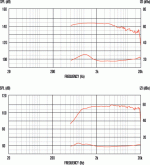
1747 factory response chart:

Last edited:
That 1747 looks very nice, especially in a system that doesn't need it to play lower. Kindhornman, it looks like a good candidate for your small horn. The 745 also isn't a direct replacement for a TAD 2001, because of its 1.4" exit.
The HF response of the 745NeoBe falls off too. I haven't tried it with EQ, but am very pleased with the way it combines with the RAAL (though it did take some fiddling).
Gary Dahl
The HF response of the 745NeoBe falls off too. I haven't tried it with EQ, but am very pleased with the way it combines with the RAAL (though it did take some fiddling).
Gary Dahl
Last edited:
View attachment 426401
Small 1.6Khz horn with TAD 2001 attached. This is where I would like to use a smaller driver with a 1.5khz to 20khz range.
That looks like the little B&C ME10 horn. I can't imagine finding a driver that would work well that low in that (if it is) I have a pair and they are really nice above 3k
Perhaps it has been so long that I am mixing up the TAD 2001 and a 4001 but I assure you that TAD is a 1" exit driver. It does work well down to 1.6khz and that is a horn that I manufactured myself. It is a rigid urethane foam horn made in two halves and bonded together. It is if I remember correctly from so long ago an exponential expansion, it may have been hyperbolic but I really don't remember anymore, I did that horn in 1985. The coverage angle is about 90x90 inclusive. I do have a few hundred of those horns sitting in storage. I do not want to add another device above this horn, I originally did that when I was using Radian drivers as their top end back then was really ragged. With the TAD driver it did not need any other device and was good to 24Khz on that horn. If I added anything at that time for the top end it was the TAD ET-703 driver and I suspect the small 1/2" drivers available today could do a similar job.
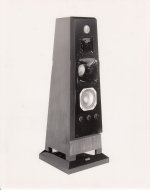
Here is a five way system with that same horn and the small ET-703 driver above it. The horn below is a 61/2" cone driven horn and below that was a custom made Radian paper cone 8" driver and below was a slot loaded down firing 10" driver. This was a killer system but was rather large and with two TAD drivers per enclosure was very expensive to say the least to produce. I personally built the enclosures and they were not easy to make and the two low frequency drivers had separate enclosures inside the larger trapezoidal enclosure. That was a Brazilian Rosewood finish and a urethane gloss black front. The three pots on the front allowed you to adjust all three horn levels independently. The two bass drivers were tuned to two different cut-off points and the ports were in the down firing position.
I know the 2001 is a 1", the horn looks like the B&C ME10 hyperbolic with it's 1.5K cutoff. The Celestion 1747 should be able to replace the 2001 but won't have 24K extension - IMO those numbers are only good for sales 15K is fine and the character of treble is between 3K and 7K anyway
Your 5 way is cool, nice and compact
Your 5 way is cool, nice and compact
View attachment 426409
Here is a five way system with that same horn and the small ET-703 driver above it. The horn below is a 61/2" cone driven horn and below that was a custom made Radian paper cone 8" driver and below was a slot loaded down firing 10" driver. This was a killer system but was rather large and with two TAD drivers per enclosure was very expensive to say the least to produce. I personally built the enclosures and they were not easy to make and the two low frequency drivers had separate enclosures inside the larger trapezoidal enclosure. That was a Brazilian Rosewood finish and a urethane gloss black front. The three pots on the front allowed you to adjust all three horn levels independently. The two bass drivers were tuned to two different cut-off points and the ports were in the down firing position.
Nice system!
Care to elaborate a bit more?
M.
Marco,
Here are some of the details that I still remember from that enclosure. The ET-703 was used from 10Khz up with no high frequency cutoff just the natural roll-off. The 1.6Khz horn was used from 1.6Khz up to the 10Khz point and cut with a second order filter. Below that at the time was a 6 1/2" paper cone driver loaded 25% of cone area and was operated down to 600hz up to the 1.6Khz point. Below that was that custom Radian driver, they made it with a paper cone rather than their normal polypropylene material, it sounded better and had a cleaner decay than the slower decaying polypro. That was tuned with a port down to if I remember correctly about 35hz. Down-firing was a 10 cone driver in a separate space loaded by the narrow slot of the base and tuned with a port to about 20hz. Both bass drivers had the same 600hz upper cutoff frequency. I didn't do the crossovers on those units, a friend of mine did all the network design at that time and he used some strange to me at the time networks. He had passive slop functions and notch filters and some unusual techniques not well understood at the time. He use to be one of the engineers at Radian way back in time so he knew the problems of those devices and in some other enclosures he did some special filtering to take care of problems he knew were in the devices that Radian didn't do anything about for years. I still talk to him and now he is doing a lot of passive networks for older Tannoy Coaxial drivers with some unusual networks again. He has been in the business since before I was ever around and goes back to the days of Bozak and many other of the early greats. I think he was involved with both Spectra-Sonics and also Phase Linear. He is a wealth of information and we often talk about really esoteric aspects of driver design. I would call him my mentor as far as driver design is concerned. He was the one who challenged me to develop the cone material that I am using today to develop my own line of speakers. He calls me when he wants to talk horn lenses.
Here are some of the details that I still remember from that enclosure. The ET-703 was used from 10Khz up with no high frequency cutoff just the natural roll-off. The 1.6Khz horn was used from 1.6Khz up to the 10Khz point and cut with a second order filter. Below that at the time was a 6 1/2" paper cone driver loaded 25% of cone area and was operated down to 600hz up to the 1.6Khz point. Below that was that custom Radian driver, they made it with a paper cone rather than their normal polypropylene material, it sounded better and had a cleaner decay than the slower decaying polypro. That was tuned with a port down to if I remember correctly about 35hz. Down-firing was a 10 cone driver in a separate space loaded by the narrow slot of the base and tuned with a port to about 20hz. Both bass drivers had the same 600hz upper cutoff frequency. I didn't do the crossovers on those units, a friend of mine did all the network design at that time and he used some strange to me at the time networks. He had passive slop functions and notch filters and some unusual techniques not well understood at the time. He use to be one of the engineers at Radian way back in time so he knew the problems of those devices and in some other enclosures he did some special filtering to take care of problems he knew were in the devices that Radian didn't do anything about for years. I still talk to him and now he is doing a lot of passive networks for older Tannoy Coaxial drivers with some unusual networks again. He has been in the business since before I was ever around and goes back to the days of Bozak and many other of the early greats. I think he was involved with both Spectra-Sonics and also Phase Linear. He is a wealth of information and we often talk about really esoteric aspects of driver design. I would call him my mentor as far as driver design is concerned. He was the one who challenged me to develop the cone material that I am using today to develop my own line of speakers. He calls me when he wants to talk horn lenses.
Pos,
The ET-703 is actually a diffraction horn and that is the normal positioning of that horn. I almost made my own lens for the driver but decided to leave it as produced. I was thinking at the time of making a matching horn that would have the same pattern as the other two horns but it did work well the way it was. Actually that device matched with the 1" TAD had the nicest high end I had ever heard up to that time. High frequencies of things like cymbals and violins and most anything else had the most detail you could imagine. I could for the first time on many music tracks identify a small triangle from say just a small cymbal, it was truly amazing the details you could hear with two Be drivers working together to produce everything from 1.6Khz on up to as high as I could possibly hear. Until I heard that I was in the same camp as many who say it doesn't matter what happens over about 16Khz, this really changed my opinion about that.
The ET-703 is actually a diffraction horn and that is the normal positioning of that horn. I almost made my own lens for the driver but decided to leave it as produced. I was thinking at the time of making a matching horn that would have the same pattern as the other two horns but it did work well the way it was. Actually that device matched with the 1" TAD had the nicest high end I had ever heard up to that time. High frequencies of things like cymbals and violins and most anything else had the most detail you could imagine. I could for the first time on many music tracks identify a small triangle from say just a small cymbal, it was truly amazing the details you could hear with two Be drivers working together to produce everything from 1.6Khz on up to as high as I could possibly hear. Until I heard that I was in the same camp as many who say it doesn't matter what happens over about 16Khz, this really changed my opinion about that.
Kindhornman, I know exactly what you mean about the Be combination: I have a TD4003+ET703 set here 
Regarding the ET703 directivity, I found the directivity above ~9kHz was larger along the horizontal dimension of the horn, whereas under 9kHz it was larger along the vertical one (diffraction).
Matching the directivity of the horn and tweeter is difficult, and it might be that the vertical orientation was a better match to your 1" expo horn in the horizontal plan (verticals are screwed anyway)
Here are the measurements:
1m distance, 5kHz HP, 0°/22°/45° along the horizontal dimension:
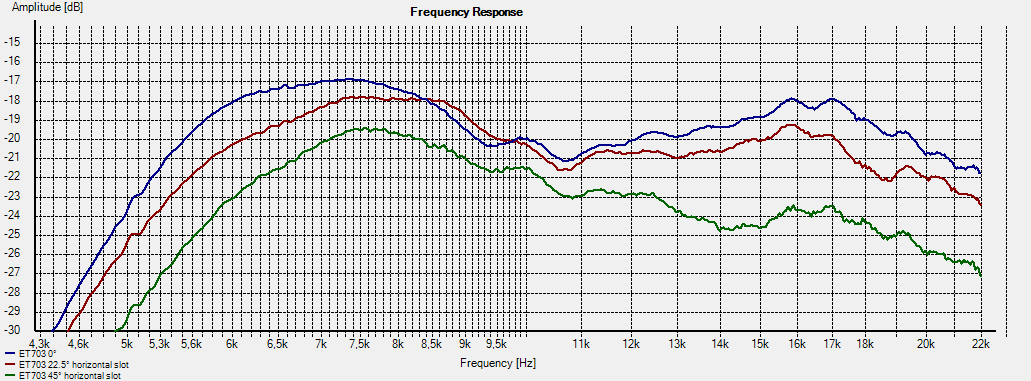
1m distance, 5kHz HP, 0°/22°/45° along the vertical dimension:
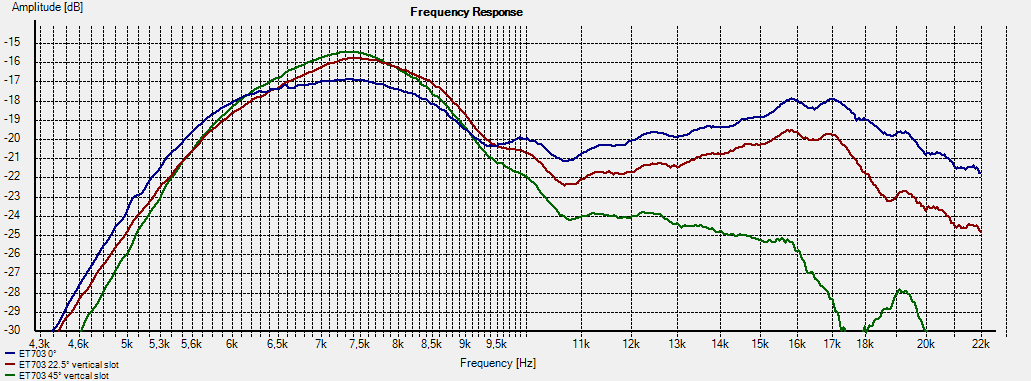
Regarding the ET703 directivity, I found the directivity above ~9kHz was larger along the horizontal dimension of the horn, whereas under 9kHz it was larger along the vertical one (diffraction).
Matching the directivity of the horn and tweeter is difficult, and it might be that the vertical orientation was a better match to your 1" expo horn in the horizontal plan (verticals are screwed anyway)
Here are the measurements:
1m distance, 5kHz HP, 0°/22°/45° along the horizontal dimension:
1m distance, 5kHz HP, 0°/22°/45° along the vertical dimension:
Attachments
Last edited:
Here are some comparative measurements of the TAD ET-703 supertweeter over at North Reading Engineering.
There's also an interesting HF/VHF combination of the Autotech Iwata 300Hz horn, Radian 950 beryllium driver, and TAD ET-703 supertweeter, complete with CLIO-measured impulse, waterfall, and FR plots.
The North Reading pages correctly display in Safari, but are mis-formatted in Chrome or Firefox. No idea how they look in the Windows version of IE.
Quick question: are the TAD ET-703's still in production, or are they another example of eBay-priced unobtanium? I ask because it seems like fewer and fewer TAD drivers are available. The only price I saw on the web was a surprising $2000 each, which is approaching ALE Acoustic or GOTO-Unit territory.
There's also an interesting HF/VHF combination of the Autotech Iwata 300Hz horn, Radian 950 beryllium driver, and TAD ET-703 supertweeter, complete with CLIO-measured impulse, waterfall, and FR plots.
The North Reading pages correctly display in Safari, but are mis-formatted in Chrome or Firefox. No idea how they look in the Windows version of IE.
Quick question: are the TAD ET-703's still in production, or are they another example of eBay-priced unobtanium? I ask because it seems like fewer and fewer TAD drivers are available. The only price I saw on the web was a surprising $2000 each, which is approaching ALE Acoustic or GOTO-Unit territory.
Last edited:
- Home
- Loudspeakers
- Multi-Way
- Beyond the Ariel
